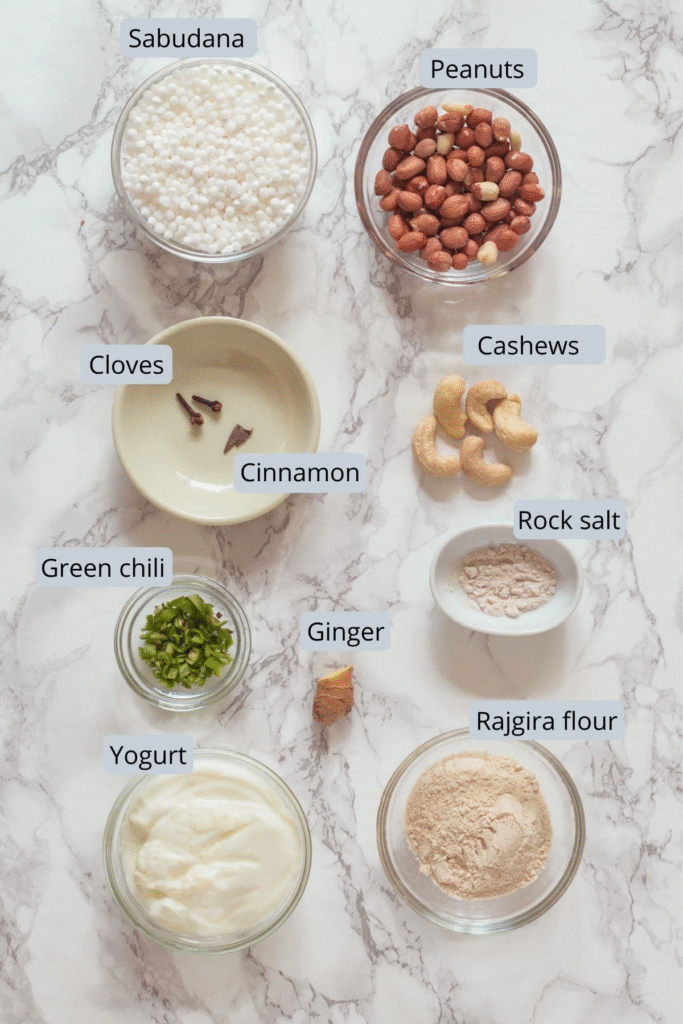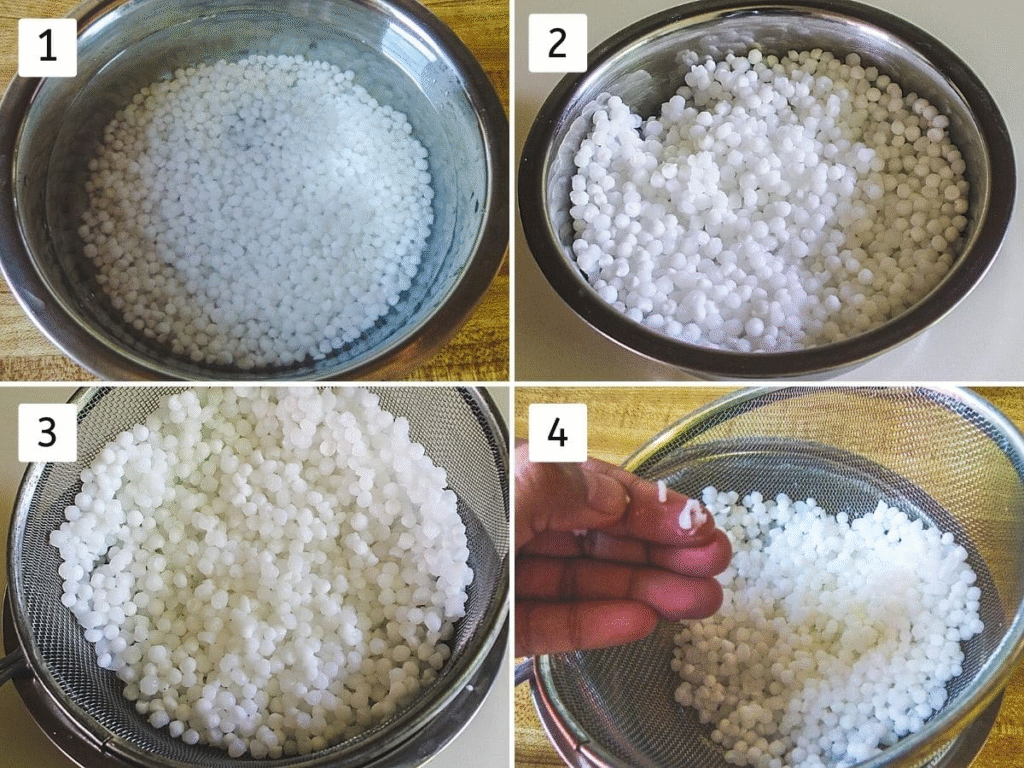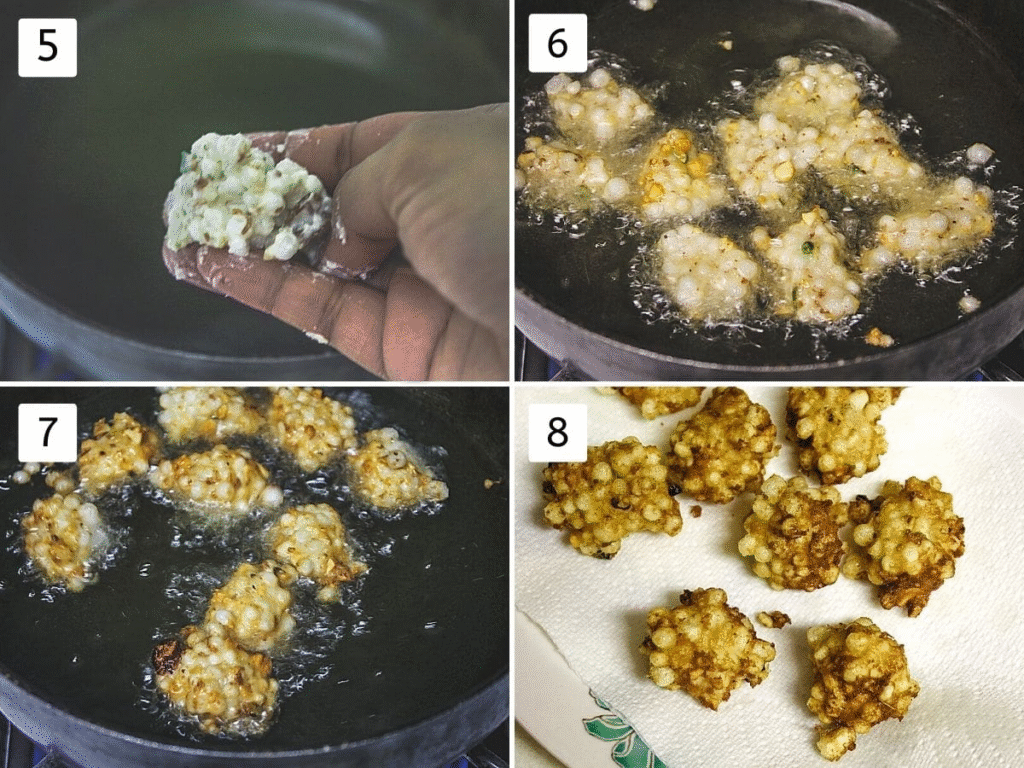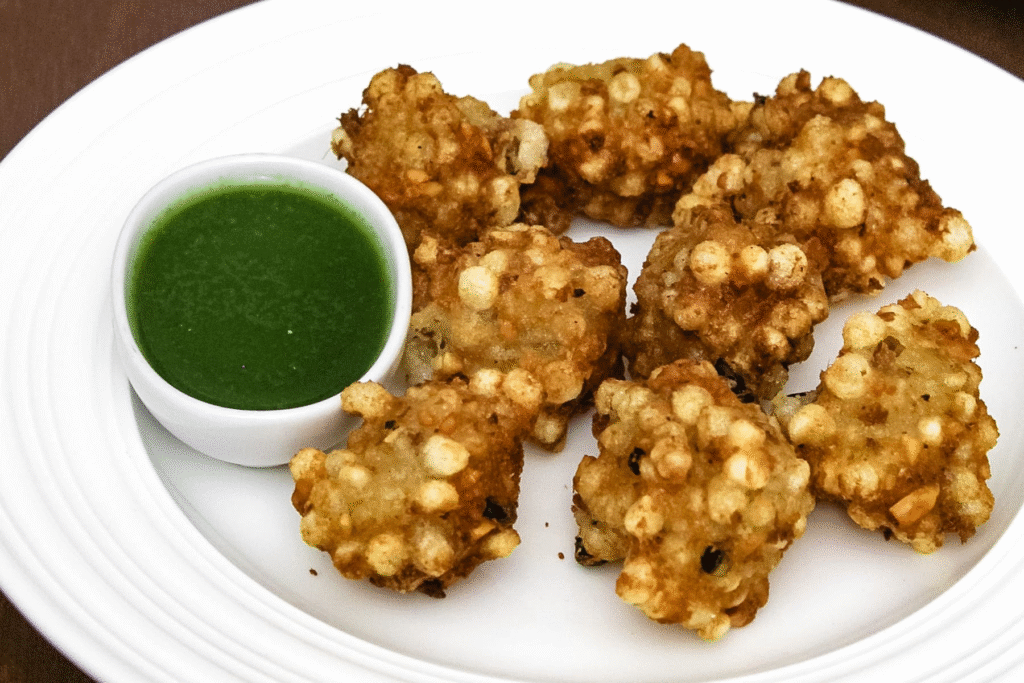Crispy outside, soft inside, golden sabudana pakoda are perfect for vrat or snack cravings. A deliciously comforting bite for Navratri, Ekadashi, or any day! These fritters turn delightfully crispy on the outside while staying soft and pillowy on the inside. A perfect bite for your vrat (Hindu fasting days) or even when you’re simply craving a comforting, crunchy snack! Whether it’s Navratri, Ekadashi, or just a cozy evening, these golden bites never fail to impress.
Made using soaked sabudana (tapioca pearls), mashed potatoes, crushed peanuts, and flavorful spices, these pakoras are not only gluten-free but also light and satisfying. Serve them hot with farali green chutney or sweet curd for a divine treat.
Great for tea-time or as a festive offering, these sabudana pakoras are sure to win hearts with their texture and taste!

❤️ About This Sabudana Pakoda Recipe
These sabudana pakoda offer a lighter and more wholesome twist compared to the classic sabudana vada. Unlike vadas, which are usually made with mashed potatoes and deep-fried until heavy and filling, this unique pakoda recipe skips the potatoes entirely. This not only makes them easier to digest but also adds a pleasant crunch, giving each bite a satisfying texture without being overly oily or heavy. The texture remains crunchy on the outside and tender on the inside—perfect for those looking for something easy to digest, especially during fasting periods.
Each ingredient used in this recipe is carefully chosen to align with Hindu fasting (vrat or upvas) guidelines. Sabudana (tapioca pearls) provides the necessary energy boost, while ingredients like sendha namak (rock salt), green chilies, and crushed peanuts bring flavor without violating fasting restrictions. These pakoras can be relished during Navratri, Ekadashi, or any other vrat days, making them a versatile and satisfying snack that’s both light and flavorful. Whether enjoyed with vrat ki chutney or a simple bowl of yogurt, these sabudana pakoras are a great way to keep your fast deliciously interesting.
🧾 Ingredient Notes
This image displays all the ingredients used to prepare sabudana pakoda. Although raisins are not visible in the ingredient shot, I did include them during preparation—you can spot them in the step-by-step photos. Adding raisins is completely optional and depends on your taste preference.

- Sabudana (Tapioca Pearls or Sago): Sabudana is a staple during Hindu fasting periods due to its high carbohydrate content. It helps provide sustained energy and keeps hunger at bay for longer hours. Its light and chewy texture makes it ideal for various vrat-friendly snacks.
- Cloves and Cinnamon: I freshly crushed these aromatic spices using a mortar and pestle to release their natural oils and intense flavors. On non-fasting days, you could substitute this with a pinch of garam masala for ease—but remember, garam masala isn’t vrat-friendly.
- Yogurt: A small amount of yogurt is added to the pakora batter, which enhances the overall flavor and gives the pakoras a delightfully fluffy and soft texture—almost melt-in-the-mouth.
- Rajgira Atta (Amaranth Flour): While besan is traditionally used in regular pakoda recipes, for fasting recipes I opt for gluten-free rajgira atta. You can also substitute it with vrat-approved flours like singhare ka atta (water chestnut flour) or kuttu atta (buckwheat flour), though each brings its own unique flavor and texture.
- Why Rajgira Atta? I personally prefer rajgira atta for its naturally sweet, nutty, and earthy flavor. It complements the tanginess of yogurt beautifully and adds depth to the pakoda’s taste without overpowering the dish.
👩🍳 How To Make Sabudana Pakoda? (Pics)
Soaking Sabudana:
1) Transfer the sabudana (tapioca pearls) into a colander and wash them well under cold running water, gently rubbing with your fingers. Continue rinsing until the water runs clear, ensuring all excess starch is removed. This step is crucial to remove excess starch, which can otherwise make the mixture gummy and hard to handle.
2) Once rinsed, soak the sabudana in enough water for 3–4 hours, or overnight for best results—especially if you’re using the variety commonly found in the USA, which typically requires a longer soaking time
3) After soaking, the sabudana pearls puff up beautifully, turning soft and translucent as they soak in the moisture, often expanding to nearly twice their original size. Drain them in a colander and allow them to rest for 15–20 minutes so any extra moisture can drain away completely.
4) To check if they’re properly soaked, press a pearl between your fingers—it should squish easily without any hard center. That’s your sign they’re ready to use in your recipe!.

Making Crushed Peanuts:
5) As the sabudana continues to drain, dry roast the peanuts over medium-low flame until they turn light golden and release a nutty aroma.
6) Allow the roasted peanuts to cool completely. Once cooled, crush them coarsely. I prefer using a mortar and pestle to retain larger, crunchy pieces that add great texture to the pakodas. Alternatively, you can use a grinder or food processor, but be cautious—it can easily turn them into fine powder, which might alter the texture of the final dish.

Making Fresh Powder:
1) Add whole cloves and cinnamon sticks to a solid, heavy-bottomed mortar. Using the pestle, begin to press and gently crush the spices in a circular motion. This releases their essential oils and rich aroma. Take your time with this step to ensure that the spices break down evenly and no large chunks remain.
2)Using firm, consistent pressure, continue to pound and swirl the partially crushed cloves and cinnamon together. Gradually transform them into a fine, fragrant powder The blend should become fine and fragrant, with a warm, spicy scent that fills the air—an indication that the spices are properly ground and ready to enhance your dish with their deep, earthy flavor.

Making Sabudana Pakoda:
1) Transfer the drained sabudana into a mixing bowl. Add coarsely crushed peanuts, freshly ground clove-cinnamon powder, sendha namak (rock salt), grated ginger, finely chopped green chilies, chopped cashews, and a few raisins. Combine everything thoroughly.
2) Stir in the yogurt and mix until evenly incorporated.
3) Sprinkle in the rajgira flour and mix again.
4) Mix everything well until you get a thick, sticky batter-like consistency that holds its shape.

5) Heat oil in a deep pan over medium flame. Once the oil is hot enough, drop small portions of the mixture using your fingertips (you can also use two spoons to shape and drop).
6) Avoid stirring for the first minute, allowing the pakoras to set—moving them too soon can cause them to disintegrate.
7) After about 1–2 minutes, gently move them around so they cook and brown uniformly on all sides.
8) Once the fritters (or whatever you’re frying) have reached a beautiful golden hue and a satisfying crunch, retrieve them gently with a slotted spoon. Transfer them onto a plate cushioned with paper towels to soak up any lingering oil

💭 Expert Tips For BEST Sabudana Pakoda
- Thoroughly Clean Sabudana: Use a colander to wash the sabudana under running water, gently rubbing the pearls between your fingers to eliminate excess starch. Avoid simply rinsing them—this step ensures non-sticky, fluffy pearls later.
- Proper Soaking is Crucial: Make sure the sabudana is soaked until it’s soft enough to mash easily when pressed between your fingers. If not soaked well, they’ll remain chewy and hard, and some may even stick to your teeth like raw pearls even after frying.
- Water Ratio for Soaking: Stick to a 1:1 ratio of sabudana to water for consistent results. Alternatively, you can pour in just enough water to cover the sabudana, with the water level about half to one inch above the pearls.
- Ensure the Oil is Hot: The frying oil must reach the right temperature before you add the pakodas. If it’s not hot enough, the mixture may disintegrate in the oil or turn greasy by absorbing too much of it.
- Let Them Set Before Stirring: Once you’ve added the pakoda batter to the hot oil, allow them to cook undisturbed for the first minute. This helps the outer layer firm up and hold its shape. Stirring too soon can cause them to fall apart and break into the oil.
🍽 Serving Ideas
- For fasting days (vrat): Serve these crispy sabudana pakoras with farali chutney made from ingredients allowed during fasts—like fresh coconut, roasted peanuts, green chilies, cumin seeds, and lemon juice. This chutney not only complements the pakoras beautifully but also keeps the meal vrat-friendly, adding a burst of flavor without breaking any dietary rules.
- For regular days: You can enjoy these pakoras with a variety of dips and sauces. A vibrant green chutney crafted from fresh coriander leaves, fragrant mint, and a medley of spices delivers a burst of freshness and zesty flavor to every bite. If you prefer something tangy and sweet, tamarind-date chutney works wonderfully. Even a simple side of tomato ketchup can be a great choice, especially for kids or those who enjoy a milder pairing. These versatile accompaniments enhance the flavor and make sabudana pakoras suitable for any occasion—be it a teatime snack or a festive treat.

